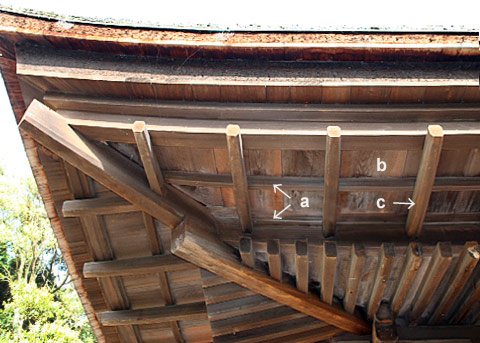|
||
 |
||

(C)2001 Japanese Architecture and Art Net Users System. No reproduction or republication without written permission.
掲載のテキスト・写真・イラストなど、全てのコンテンツの無断複製・転載を禁じます。
|
||||||
| komai 小舞 | ||||||
| KEY WORD : architecture / general terms | ||||||
| Also written 木舞. In the SHOUSOIN MONJO 正倉院文書 it appears as 古麻比 komai and in other old documents as 古万比. The lath used on top of rafters *taruki 垂木, beneath sheathing *noji-ita 野地板, and roofing materials. Sometimes the lath is made of bamboo, especially for thatched roofs *kayabuki 茅葺. If there is no ceiling and the lath is exposed or if it is under the eaves *noki 軒, it is given a smooth finish. Often ordinary lath and bamboo are used together. Lath strips and supporting bamboo are set like latticework, about every 30cm apart and secured to the penetrating tie beam *nuki 貫. The bamboo lath is bound together with rope called komainiwa 小舞庭 or waranawa 藁縄 about every 3-4cm. A roof lath is called yane komai 屋根小舞. A lath used under the eaves is called *hirokomai 広小舞 because it is wider than ordinary laths. The Komai is named according to its location, use and shape: *nokomai 野小舞 is a hidden lath, nukikomai 貫小舞 a lath that penetrates other members, warikomai 割小舞 a split-board or split bamboo lath, and shikikomai 敷小舞 a lath that is meant to be seen for its ornamental quality. It is located underneath the ordinary type. The decorative lath is commonly used in sukiya style architecture *sukiya-zukuri 数寄屋造 and tea architecture. Laths are also used as a support under plaster or daub walls. They form a common substructure for a wall style called *shinkabe-zukuri 真壁造. | ||||||
 |
||||||
| REFERENCES: | ||||||
| *kabekomai 壁小舞, *koushi 格子 | ||||||
| EXTERNAL LINKS: | ||||||
| NOTES: | ||||||
(C)2001 Japanese Architecture and Art Net Users System. No reproduction or republication without written permission. 掲載のテキスト・写真・イラストなど、全てのコンテンツの無断複製・転載を禁じます。 |
||||||